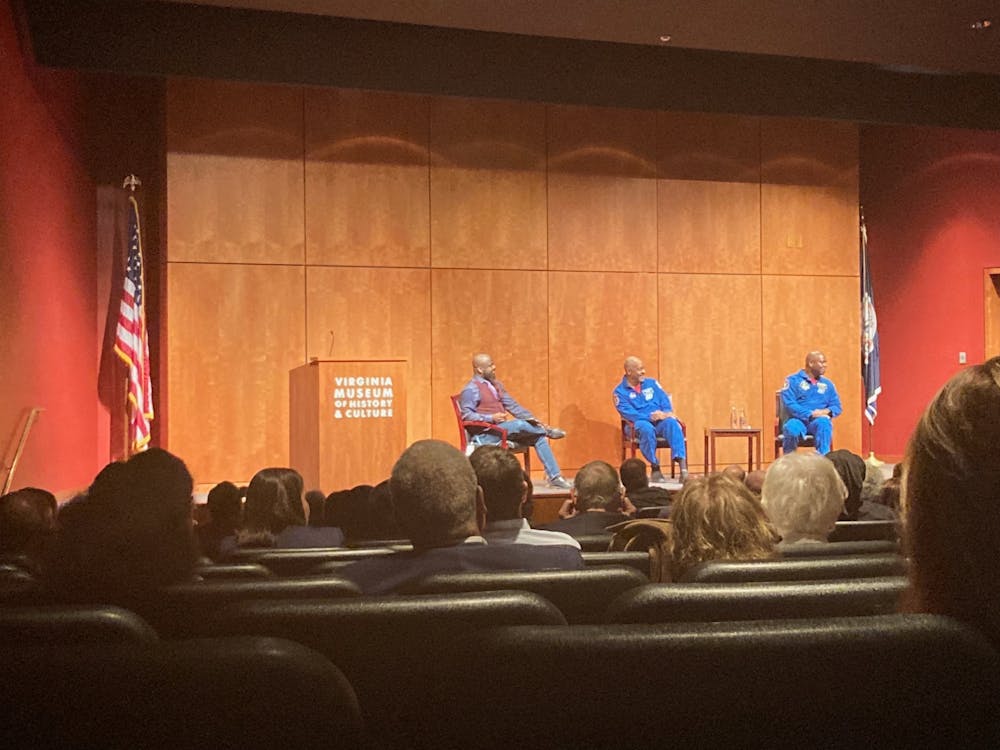On the evening of Oct. 25, Leland Melvin, ‘86, had an audience of hundreds captivated by his stories of perseverance as an astronaut at NASA. He was joined on stage – as he was in space – by his friend and fellow former astronaut Robert Satcher. They traveled aboard the shuttle Atlantis in 2009, marking the first time two African-American men were in space together.
Melvin told the crowd what he remembers about the day humans first landed on the moon in 1969 when he was just 5 years old. He said he saw no one who looked like him on the TV screen and joked that this was in part because he was actually behind the TV set, holding the antenna in the right way so his family could watch a good transmission.
He recalled the next day when all the other kids wanted to play ‘astronaut’ on the playground.
“I’ll never forget the, ‘Who’s gonna be Neil? Who’s gonna be Buzz?’ And I was like, I don’t want to be any of them,” Melvin said. “I didn’t see it, first of all… and again, they don’t look like me.”
The event at the Virginia Museum of History and Culture was co-presented by the University of Richmond and VMHC as part of the museum’s “Apollo: When We Went to the Moon” exhibit. The Robins Family Forum, a theater in the museum, was packed with museum members, UR students, kids, parents – including Satcher’s – and even a member of the United States Space Force.
The purpose of STS-129, the mission Melvin and Satcher were on together, was to deliver equipment to the International Space Station. It launched with six astronauts on Atlantis, and a seventh traveled with them from the ISS back to Earth. It was NASA’s 160th manned space flight and was completed in just under 11 days. This was Satcher’s only mission.
Satcher, who was an orthopedic surgeon before becoming an astronaut, said that he joined NASA afterin part because of meeting Melvin during Satcher's medical residency.
“He encouraged me to do it, and we stayed in contact after that,” Satcher said. “And that led to my actually applying to be an astronaut.”
As the crowd applauded, Satcher and Melvin fist-bumped each other –-- something they did several times throughout the night.
Satcher responded to a question about perseverance by pushing Melvin to share a story of when he underwent emergency surgery during training. When a spacesuit given to him was missing a protective piece for his ears, an exercise in a 6 million gallon pool caused Melvin to lose his hearing. He regained it in his right ear three weeks later, but due to the high fitness standards for astronauts, he was told he would never be able to fly in space, he said.
After the Space Shuttle Columbia disaster in 2003, Melvin took flights to the memorial services of his friends who were killed. NASA’s chief health and medical officer, who was traveling with Melvin, noticed him clearing his ears as he struggled with the adjusting air pressure at takeoff and landing of every flight, he said.
“And he said to me, ‘You know what, you didn’t give up on the [victim’s] families, you didn’t give up on NASA, I’m gonna give you a chance to fly in space,’” Melvin said. “And he signed me a waiver to fly with my ear, because he believed in me, and I believed in our NASA community, our family.”
Enjoy what you're reading?
Signup for our newsletter
Melvin traveled to space twice during his career, and stayed inside either the Atlantis or the ISS throughout his 23 days there because of his ear. Before Melvin’s retirement from NASA in 2014, he served as its associate administrator for education, where he led work on programs to inspire interest in STEM.
UR President Kevin Hallock attended the event with his wife, Tina Hallock. Kevin Hallock introduced the astronauts, whom he called “two Virginia history-makers.” He talked about how he presented Melvin with an honorary degree earlier this year, and Melvin’s service to UR as a trustee emeritus.
“I am so grateful to know him and count him as a friend of our University, and a friend to me and Tina,” Hallock said.
During his time at UR, Melvin was a record-breaking football player. He is a member of the Richmond Athletics Hall of Fame, and at the time of his first trip to space in 2008, he held the record for the most receptions in Spider football history. Melvin was drafted to the NFL in 1986, but was unable to play because of injuries during training camp.
Kiran Gupta, a law student on exchange from Sydney, Australia, said the event was an opportunity to hear about the challenges and rewarding elements of going to space.
“It was wonderful to learn from them,” Gupta said. “They have such inspirational stories.”
The conversation was followed by a Q&A and then a reception with food, drinks and a chance to meet the astronauts. Melvin’s 2017 memoir, “Chasing Space: An Astronaut’s Story of Grit, Grace, and Second Chances,” was on sale in the gift shop.
Senior Camila Marroquin Merida, who is on exchange from Paris, attended the event and was able to meet the astronauts, where she got her copy of Melvin’s book signed.
“It was unreal to meet people who went to space,” she said. “It was very nice to see that they were just normal people, and very kind and very down-to-earth.”
Contact writer Kieran Flood at kieran.flood@richmond.edu.
Support independent student media
You can make a tax-deductible donation by clicking the button below, which takes you to our secure PayPal account. The page is set up to receive contributions in whatever amount you designate. We look forward to using the money we raise to further our mission of providing honest and accurate information to students, faculty, staff, alumni and others in the general public.
Donate Now



